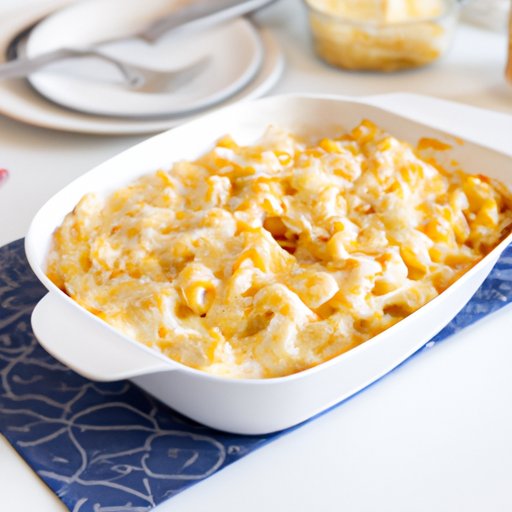I. Introduction
Baked mac and cheese is a classic comfort food that warms hearts and fills stomachs. Whether it’s served as a side dish or as the main course, nothing beats a good, homemade mac and cheese. But with so many variations and recipes out there, it can be overwhelming to know where to start. That’s where we come in; we’ve got you covered. This article will guide you through all the steps to make the perfect baked mac and cheese, provide you with creative recipe variations, and offer hassle-free cooking hacks and tips.
II. A Step-by-Step Guide to the Perfect Baked Mac and Cheese
Before jumping into cooking, it’s essential to select the right ingredients that will make a noticeable difference in taste for your baked mac and cheese. Start with high-quality pasta; elbow or spiral shape is traditional, but feel free to experiment with other shapes. When it comes to cheese, the combination of cheddar and Gouda will yield a creamy and sharp flavor. Parmesan cheese sprinkled on top of the baked mac and cheese will add a lovely nutty flavor.
Next, making the cheese sauce is the key to a perfect baked mac and cheese. Here’s a quick recipe:
– 4 tbsp all-purpose flour
– 4 tbsp unsalted butter
– 2 cups whole milk or heavy cream
– 2 cups shredded cheese
– Salt and pepper to taste
In a saucepan over medium heat, melt the butter, add flour, and stir to combine. Add milk or cream slowly, whisking continuously until the mixture thickens, then simmer for about two minutes. Add shredded cheese and mix until melted. Season with salt and pepper.
The pasta needs to be boiled in salted water until it’s al dente, meaning it has a slight bite to it. Overcooked pasta can result in a mushy, sticky mac and cheese. After boiling, drain and rinse pasta in cold water to prevent further cooking.
With the cheese sauce and pasta ready, combine them in an oven-safe baking dish. Sprinkle the top layer with parmesan cheese and breadcrumbs for an extra crispy texture. Bake the mac and cheese for 20-25 minutes at 350°F or until the top is golden brown.
For an even more perfect mac and cheese, remember to let the dish cool for a few minutes before serving. This will allow the cheese sauce to settle and thicken, making each bite even more delicious.
III. The Best Baked Mac and Cheese Recipe Variations
If you’re feeling adventurous and want to experiment with different flavors, consider using these cheese options:
– Smoked Gouda for a stronger, woodsy flavor;
– Blue cheese for a salty and tangy taste;
– Swiss cheese for a nutty and earthy flavor;
– Monterey Jack cheese for a milder and creamy flavor.
If you want to add some extra texture and flavor to your mac and cheese, try some of these creative add-ins:
– Crispy bacon or pancetta;
– Breadcrumbs or panko bread crumbs for extra crunch;
– Jalapeños or roasted red peppers for a subtle spicy flavor;
– Sautéed onions or garlic for a savory taste.
For seasoning, try adding some newly ground pepper or nutmeg to your cheese sauce for extra depth of flavor. You can also sprinkle some herbs such as thyme, parsley, or chives on top when serving for a fresh, fragrant kick.
IV. Easy Baked Mac and Cheese Hacks for Busy Cooks
We understand that time is precious, and baking mac and cheese can take some effort. Here are some hacks to simplify the process:
– Use pre-made cheese sauce instead of making it from scratch. It won’t be as delicious, but it will save plenty of time.
– Use frozen cooked pasta to save time cooking it from scratch.
– Prep the dish ahead of time and refrigerate it until you’re ready to bake it.
These tips will make it simpler and quicker to achieve that perfect, cheesy goodness that you desire, even on your busiest days.
V. Baked Mac and Cheese for Allergy-Friendly Diets
If you have dietary restrictions, you can indeed still enjoy a delicious baked mac and cheese with these substitution suggestions:
– Gluten-free pasta, such as rice, quinoa, or corn pasta.
– Vegan cheese or nutritional yeast for a dairy-free version of cheese sauce that still has a cheesy taste.
– Use almond, coconut, or soy milk as a substitute for cow’s milk.
– Replace butter with vegan butter or plant-based oils such as olive oil or coconut oil.
These allergy-friendly alternatives are just as tasty and satisfying as traditional baked mac and cheese, while still catering to your unique dietary needs.
VI. Healthier Baked Mac and Cheese Alternatives
If you’re looking for a healthier version of mac and cheese, you can experiment with these options:
– Use whole-grain pasta instead of white-flour pasta for extra fiber and nutrients.
– Use vegetable-based sauces such as butternut squash or carrots for a more wholesome sauce that’s still creamy and delicious.
– Use low-fat cheeses or decrease the amount of cheese to reduce the calories and saturated fat in the dish.
If you’re interested in trying out a few healthier baked mac and cheese recipes, consider the following:
– Quinoa mac and cheese, which uses quinoa instead of pasta, and nutritional yeast for a vegan sauce;
– Cauliflower mac and cheese, which uses grated cauliflower instead of pasta and is loaded with veggies and low-fat cheese;
– Spaghetti squash mac and cheese, which uses spaghetti squash in place of pasta and a butternut squash-based cheese sauce.
VII. Conclusion
It’s no secret that baked mac and cheese is an all-time favorite comfort food, and now you’re equipped with all the tools and tips to create the perfect version! Whether you opt for traditional cheese or variations inspired by exotic flavors, make-ahead preparations, hassle-free cooking hacks, or healthier options, your ultimate comfort food can be baked to perfection your way. We urge you to experiment, and the possibilities are endless.
